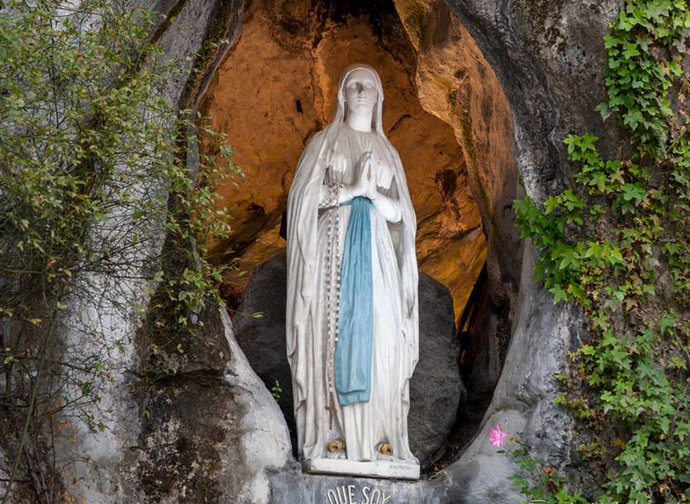Lourdes doctor: 'This is how 71st miracle was recognised'
This is the 71st officially recognised miracle by grace of Our Lady of Lourdes: the healing of John Traynor, an English sailor paralysed in both legs, who was cured during a pilgrimage to Lourdes in 1923. Dr Alessandro de Franciscis, director of the Medical Records Office, explains to Niedziela how this recognition came about - 101 years later.

An interview with Alessandro de Franciscis by Wlodzimierz Redzioch, published in the Polish Catholic weekly Niedziela (Sunday).
---
Monsignor Malcolm Patrick McMahon, Archbishop of Liverpool, on 8 December last year, the Feast of the Immaculate Conception, officially recognised as miraculous the healing of a Liverpudlian more than a hundred years ago. In his decree, the Archbishop explained that it was a spectacular healing that took place during a pilgrimage in 1923 and in the presence of several doctors. This brought the total number of miracles in Lourdes to 71.
I discussed John Traynor’s miraculous healing, which took place in Lourdes, with Dr Alessandro de Franciscis, the director of the Sanctuary's Medical Observatory.
Doctor de Franciscis, who was this young Englishman from Liverpool who was recently recognised as the 71st miracle of Our Lady of Lourdes?
John Traynor was a young working-class man who served as a reservist in the British Royal Navy, during the Great War of 1914-18. During the Battle of the Dardanelles, he was hit by shrapnel in his skull and right arm, causing paralysis of his right upper limb. Instead, the damage to his brain left him a severe epileptic. He was sent back to hospital in England. Traynor was operated on using the then-current method of drilling into the skull to reduce intracranial pressure. Unfortunately, the operation left him paralysed in both legs. And so the young man became seriously ill. In this condition he was declared a war veteran and sent to a sort of care home.
Why did this paralysed man want to go on a pilgrimage to Lourdes?
It was in that year that Traynor decided to go on a pilgrimage to the shrine of Lourdes, first organised by his diocese of Liverpool in 1923, despite the efforts of many of his friends, including a priest who was well aware of his frailty, to discourage him.
Was Traynor a Catholic?
Yes, his mother, an Irish Catholic who died prematurely when he was still a child, had passed on to him a great love for Our Lady.
What was the journey to Lourdes like?
It was a long and complicated journey from Liverpool to Lourdes, considering that he was a person who could not even walk. But Traynor finally arrived at the shrine: he bathed in the baths on the afternoon of 25 July. Later, after the Eucharistic procession, something extraordinary happened: during the blessing of the Blessed Sacrament, a force entered his body: his legs suddenly began to move, his arm was raised to make the sign of the cross in the air. And immediately the man was considered to have been miraculously cured.
In 1926, now cured and strong, Traynor decided to return to Lourdes as a volunteer stretcher-bearer. At the sanctuary, he submitted himself to the collegial expertise of the Bureau des Constatations Médicales. His expertise was so important and his recovery so spectacular that a report of the medical examination, signed by my predecessor, Dr August Vallet, was published in 1926. The witnesses were three doctors who had been on the pilgrimage in 1923 and had seen Traynor before and after his recovery.
This report was published in the Journal de la Grotte, the official press organ of the shrine, but was never sent to the Diocese of Liverpool.
Why was this?
The problem is that at that time there was no clearly defined procedure, as we have today, for dealing with such cases, so this publication was not forwarded to the Bishop of Liverpool.
And was it forgotten about?
For many years, yes. Just think that in 1993 the Liverpool diocesan weekly asked the question: "Why was this citizen of ours not declared a miracle? Also because Traynor went to Lourdes as a volunteer stretcher-bearer till the end of his life.
And how did Traynor's case come to the fore?
On the occasion of the centenary of the first pilgrimage to Lourdes from the diocese of Liverpool, some of my colleagues asked me why Traynor's case had never been studied. So I asked a medical colleague, Dr Kieran Moriarty, a British member of the International Medical Committee of Lourdes, to analyse Traynor's file in the archives of the Liverpool diocese. Dr Moriarty found little, including a yellowed photocopy: it was a photocopy of the Journal de la Grotte with the report of Dr Vallet, who had examined Traynor in July 1926, together with the three doctors (Drs Azurdia, Finn and Marley) who had examined Traynor both before and after his recovery. His report concluded: 'We acknowledge and declare, with our brethren, that the process of this miraculous cure is absolutely outside and above the forces of nature.
And what did you do next?
At the beginning of last summer, I gave all this material to my bishop of Tarbes-Lourdes, Mgr Jean-Marc Micas. I explained to him that there was nothing to be done medically because everything was certified. My bishop then wrote to the Bishop of Liverpool with all the material I had prepared. The archbishop then set up a canonical-diocesan commission. I myself was interviewed in November and gave my version of events. The Archbishop saw fit to sign the decree on 8 December 2024, the Feast of the Immaculate Conception. He also decided to hold a great celebration in the cathedral on 18 February, the day of the liturgical feast of St Bernadette Soubirous. Both the Bishop of Tarbes-Lourdes and myself, as head of the Office of Medical Observance, were invited to the ceremony in Liverpool.
What does this official recognition of the 71st miracle of Lourdes mean?
It is a sign of the goodness of God and of the Immaculate Conception. And it is also important that the official recognition has been proclaimed on the eve of the Jubilee of 2025, which Pope Francis has dedicated precisely to hope, the hope that millions of pilgrims carry in their hearts when they go to the Sanctuary of Lourdes.




